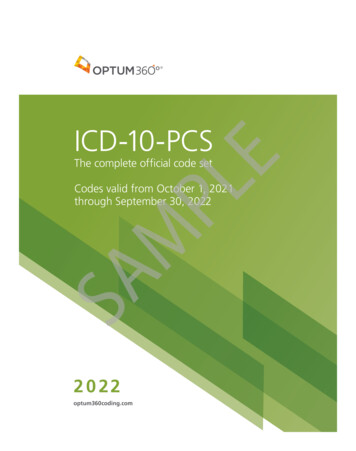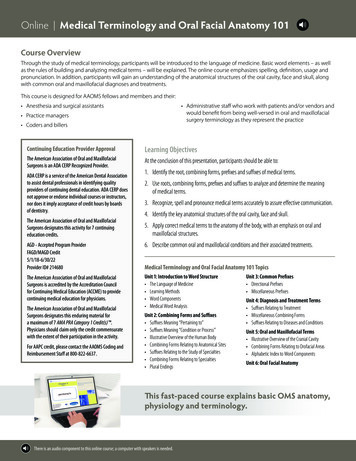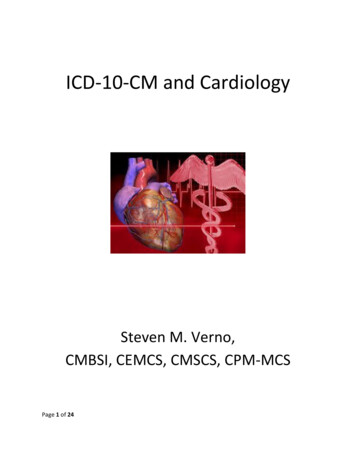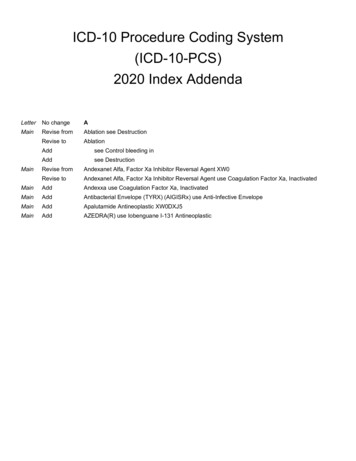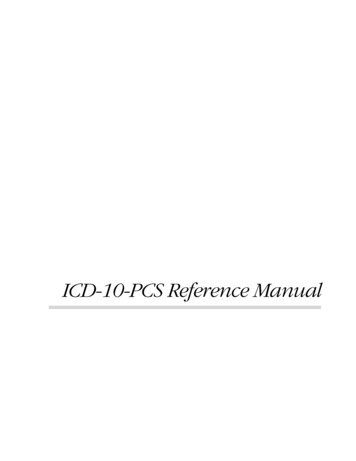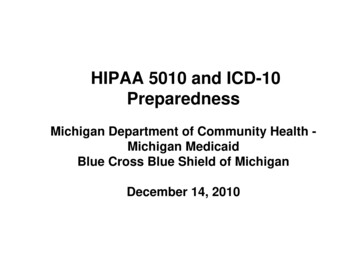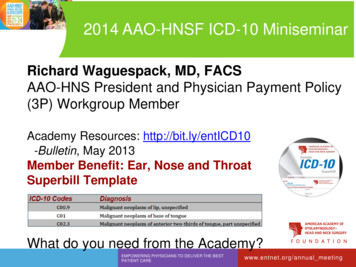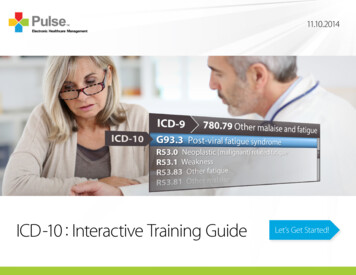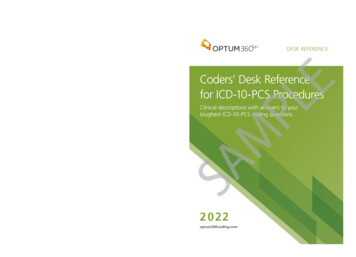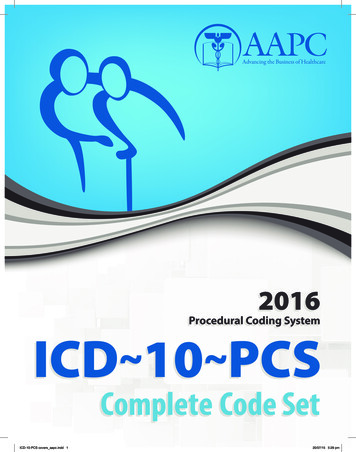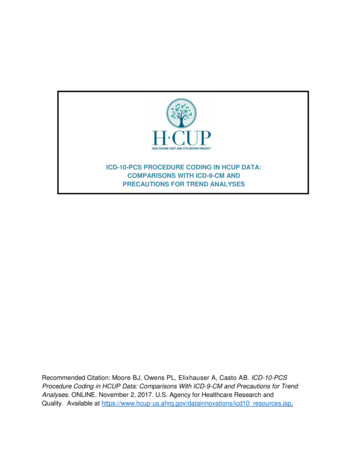
Transcription
ICD-10-PCS PROCEDURE CODING IN HCUP DATA:COMPARISONS WITH ICD-9-CM ANDPRECAUTIONS FOR TREND ANALYSESRecommended Citation: Moore BJ, Owens PL, Elixhauser A, Casto AB. ICD-10-PCSProcedure Coding in HCUP Data: Comparisons With ICD-9-CM and Precautions for TrendAnalyses. ONLINE. November 2, 2017. U.S. Agency for Healthcare Research andQuality. Available at https://www.hcup-us.ahrq.gov/datainnovations/icd10 resources.jsp.
TABLE OF CONTENTSExecutive Summary .1Introduction .3Brief Overview of ICD-9-CM Versus ICD-10-PCS . 3Brief Description of the HCUP State Inpatient Databases . 3Coding of Procedures Under ICD-10-PCS .4Comparison of the ICD-9-CM and ICD-10-PCS Code Structure . 4ICD-10-PCS Code Description Terminology . 7How the CCS for ICD-10-PCS Was Developed . 8Methods .9Results.10CCS Procedure Categories With High Volumes Prior to ICD-10-PCS .11CCS Procedure Categories With Large Decreases in Volume in ICD-10-PCS .15CCS Procedure Categories With Large Increases in Volume in ICD-10-PCS .18CCS Procedure Categories With Stable Volumes Between ICD-9-CM and ICD-10-PCS .23CCS Categories That Are No Longer Populated Under ICD-10-PCS .28Conclusion .29Appendix A: ICD-10-PCS Root Operation Definitions .31Appendix B: Healthcare Cost and Utilization Project Partner Organizations .33Appendix C: Changes in CCS Procedure Categories From ICD-9-CM to ICD-10-PCS, Sorted byCCS Number (Body System) .35Appendix D: Changes in CCS Procedure Categories From ICD-9-CM to ICD-10-PCS, Sorted byPercentage Change From 2014 to 2015 .44INDEX OF FIGURESFigure 1. ICD-9-CM and ICD-10-PCS Procedure Coding Systems . 4INDEX OF TABLESTable 1. Brief Comparison of ICD-9-CM and ICD-10-PCS Procedures, October 1, 2015 . 5Table 2. ICD-10-PCS Character Values . 6Table 3. Examples of ICD-10-PCS Description of Procedures Compared With ICD-9-CMTerminology . 8Table 4. Frequency of Inpatient Stays With High-Volume Surgical Procedures Prior to ICD-10PCS (2013 and 2014), by CCS Procedure Category .12Table 5. Frequency of Inpatient Stays With a Laminectomy Procedure .13HCUP (11/02/17)iICD-10-PCS Procedure Codingin HCUP Data
Table 6. CCS Procedure Categories With a Decrease in Frequency of at Least 50 PercentDuring the Transition From ICD-9-CM to ICD-10-PCS .15Table 7. Frequency of Inpatient Stays With a Small Bowel Resection Procedure .16Table 8. CCS Procedure Categories With an Increase in Frequency of at Least 50 PercentDuring the Transition From ICD-9-CM to ICD-10-PCS .18Table 9. Frequency of Inpatient Stays With a Procedure From the CCS Category OtherOperating Room Therapeutic Procedure on Skin and Breast .19Table 10. High-Volume CCS Procedure Categories in the SID That Changed in Frequency byNo More Than 20 Percent From ICD-9-CM to ICD-10-PCS .23Table 11. Frequency of Inpatient Stays With a Coronary Artery Bypass Graft (CABG) Procedure.25Table 12. Frequency of Inpatient Stays With a Hysterectomy Procedure .27Table 13. CCS Procedure Categories With No Cases in Quarter 4 2015 With ICD-10-PCS.28HCUP (11/02/17)iiICD-10-PCS Procedure Codingin HCUP Data
EXECUTIVE SUMMARYThis document examines challenges in creating consistently defined groupings of inpatientprocedure codes for trend analyses that incorporate procedure codes from both theInternational Classification of Diseases, Ninth Revision, Clinical Modification (ICD-9-CM) andInternational Classification of Diseases, Tenth Revision, Procedure Coding System (ICD-10PCS). The analysis uses Agency for Healthcare Research and Quality (AHRQ) HealthcareCost and Utilization Project (HCUP) data from 24 State Inpatient Databases (SID) in 2013,2014, and 2015 to track and compare procedure volume across the two coding systems.Main Findings Starting on October 1, 2015, there were 72,589 valid ICD-10-PCS procedure codes,representing a nearly 20-fold increase from the 3,824 valid ICD-9-CM procedure codes.ICD-10-PCS procedure codes are structured differently from ICD-9-CM codes, providemore details, and do not always rely on conventional procedural or surgical terminologyto describe the procedures in each code.Grouping individual ICD-9-CM and ICD-10-PCS codes into broad categories of relatedprocedures may not solve the discrepancies in the two coding systems. For example,many Clinical Classifications Software (CCS) categories exhibit stark differences intrends following the transition to ICD-10-PCS coding, even though they were designed tocapture similar types of hospital procedures.Appendices to this document provide a comprehensive assessment of the notabledifferences in counts of procedures across the coding periods. These tables identifyprocedures where changes in the coding system mean that individual ICD codes shouldbe examined.Of the 231 CCS procedure categories, only 40 had changes in frequencies that wereless than 5 percent across the ICD-9-CM to ICD-10-PCS coding transition period. For22 CCS procedures, frequencies decreased by more than 50 percent, while frequenciesincreased by more than 50 percent for 48 CCS categories. For 60 CCS categories,frequencies changed by 20 to 49 percent. For 53 CCS categories, frequencies changedby 5 to 19 percent. For the remaining 8 CCS categories, no ICD-10-PCS codes couldbe defined.There are numerous reasons for differences in observed procedure trends across theICD-9-CM to ICD-10-PCS transition, including but not limited to removal of diagnosticinformation from ICD-10-PCS codes, changes in the terminology used to capture thesalient concept of a procedure or the conventional terminology for a given specialty,underlying changes to the ICD body part and chapter assignments, and use of multipleICD-10-PCS codes for procedures that previously were represented with a single codein ICD-9-CM.ICD-10-PCS is undergoing continuous revisions, modifications, and improvements. It will taketime for professional coders, surgeons, hospital staff, and researchers to become familiar withthe new system. In addition, changes are expected as professional coding guidelines andcoding assistance software continue to evolve.HCUP (11/02/17)1ICD-10-PCS Procedure Codingin HCUP Data
It will be important to develop new categorization schemes under ICD-10-PCS to enableresearchers to group clinically meaningful procedures for analysis. Specifically, it isrecommended that a clinical procedure grouping scheme be developed that maps ICD-10-PCScodes into groupings that reflect clinical, procedural, and surgical terminology. Initial effortscould focus on a select group of surgical procedures (e.g., hysterectomy, laminectomy, coronaryartery bypass graft, colorectal resection) that have high volumes and high aggregate costs.When using HCUP data that include both ICD-9-CM and ICD-10-CM/PCS codes, researchersare encouraged to examine the frequency of individual procedure codes reported by quarter todetermine whether it is advisable to combine data across the two coding time periods to studytrends. In many cases, it may not be possible to study trends over the ICD-10-CM/PCStransition.HCUP (11/02/17)2ICD-10-PCS Procedure Codingin HCUP Data
INTRODUCTIONThe purpose of this document is to provide users of Agency for Healthcare Research andQuality (AHRQ) Healthcare Cost and Utilization Project (HCUP) data with examples of howtransitioning from the International Classification of Diseases, Ninth Revision, ClinicalModification (ICD-9-CM) to the International Classification of Diseases, Tenth Revision,Procedure Coding System (ICD-10-PCS) may affect analyses of inpatient data.It is important to note that the examples provided in this document are for illustrative purposesonly and are not comprehensive of all instances in which the transition to the ICD-10-PCScoding system affects the ability to follow trends in hospital inpatient procedures using individualICD codes or categorization schemes such as the Clinical Classifications Software (CCS).AHRQ encourages additional research on the topic to bring the issue to the forefront and speedthe rate at which useful guidance and identification of unforeseen problems with the new codingsystem can be discovered and disseminated.In this document, we provide some examples of discontinuities when examining trends acrossICD-9-CM and ICD-10-PCS procedure codes. We present an approach to examining trendswith the CCS categories by exploring individual codes within the procedure categories. Ourgoal is to alert users about the impact of the new coding system on research and data analytics.Brief Overview of ICD-9-CM Versus ICD-10-PCSOn October 1, 2015, the United States transitioned from using ICD-9-CM to ICD-10-CM/PCScode sets to report medical diagnoses and inpatient procedures. ICD-10 consists of two parts: ICD-10-CM: diagnosis coding on inpatient and outpatient billing and claims data ICD-10-PCS: procedure coding on inpatient billing and claims data.An overview of key differences between ICD-9-CM and ICD-10-CM diagnoses is available onthe HCUP-US Web site under ICD-10-CM/PCS Resources. A more detailed comparison of theICD-9-CM and ICD-10-CM diagnosis codes is available in the HCUP Methods Series Report#2016-02, Impact of ICD 10-CM/PCS on Research Using Administrative Databases. Thisdocument focuses on differences between the ICD-9-CM and ICD-10-PCS procedure codingsystems.Brief Description of the HCUP State Inpatient DatabasesThe State Inpatient Databases (SID) include discharge-level data on inpatient stays from most,if not all, hospitals in the State. The SID include all types of inpatient stays, including transfersfrom another acute care hospital and stays that originated in the hospital emergency department(ED). The SID can be used to investigate questions unique to one State, to compare data fromtwo or more States, to conduct market-area variation analyses, and to identify State-specifictrends in inpatient care utilization, access, charges, and outcomes.HCUP (11/02/17)3ICD-10-PCS Procedure Codingin HCUP Data
Starting on October 1, 2015, the SID include ICD-10-CM/PCS diagnosis and procedure codes.Thus, in the 2015 data year, three quarters of data were coded using ICD-9-CM and the lastquarter was coded using ICD-10-CM/PCS.CODING OF PROCEDURES UNDER ICD-10-PCSComparison of the ICD-9-CM and ICD-10-PCS Code StructureFigure 1 and Table 1 compare the ICD-9-CM and ICD-10-PCS procedure coding systems withrespect to organization and structure, code composition, and level of detail in procedure codes.Figure 1. ICD-9-CM and ICD-10-PCS Procedure Coding SystemsAbbreviations: ICD-9-CM, International Classification of Diseases, Ninth Revision, Clinical Modification;ICD-10-PCS, International Classification of Diseases, Tenth Revision, Procedure Coding System.Source: Gibson T, Casto A, Young J, et al. Impact of ICD-10-CM/PCS on Research Using AdministrativeDatabases. HCUP Methods Series Report #2016-02. Rockville, MD: Agency for Healthcare Research andQuality; 2016. s.jspHCUP (11/02/17)4ICD-10-PCS Procedure Codingin HCUP Data
Table 1. Brief Comparison of ICD-9-CM and ICD-10-PCS Procedures, October 1, 2015ICD-9-CMICD-10-PCS3,824 codes72,589 codesChapters organized by body systemMultiaxial structure to chapters3–4 characters7 characters must be usedAll characters are numericEach character can be alpha (A–H, J–N, P–Z) ornumeric (0–9)Decimals after 2 charactersNo decimalNo placeholder characterThe placeholder “Z” is used when a codecontains fewer than 6 charactersIncludes combination codes in whichprocedures that typically are performedtogether are combined into one procedurecodeDoes not include combination codes; mayrequire multiple codes to capture what asurgeon considers a single procedureLacks information on lateralityDesignates the left or the right side of the bodywhen describing the location of proceduresLacks descriptions of methodology andapproachProvides detailed descriptions of methodologyand approachGeneric terms for body partsSpecific terms for body partsGeneric terms for device usedSpecific terms for device usedMay contain diagnostic information (i.e.,diagnoses and procedures may be linked)Does not contain diagnostic information (i.e.,diagnoses and procedures are not linked)Contains code options for “not otherwisespecified” and “not elsewhere classified”No explicit “not otherwise specified” codes andlimited use of “not elsewhere classified”Limited space for adding new codesFlexible for adding new codesUses conventional medical terminologyIntroduces a novel approach to describingprocedures that does not rely on conventionalprocedural and surgical termsaAbbreviations: ICD-9-CM, International Classification of Diseases, Ninth Revision, Clinical Modification;ICD-10-PCS, International Classification of Diseases, Tenth Revision, Procedure Coding System.a Examples are provided in Table 3.Source: Casto AB (ed). ICD-10-PCS Code Book, 2016. Chicago, IL: American Health InformationManagement Association; 2016.HCUP (11/02/17)5ICD-10-PCS Procedure Codingin HCUP Data
The different characters of the ICD-10-PCS codes have specific meanings.1 Table 2 provides alist of available character values for each position. The character “Z” is used in any position asa placeholder if another meaningful character is not used. The fourth, sixth, and seventhcharacters exhibit considerable variation across the full range of ICD-10-PCS codes. In theinterest of space, the complete set of values for those characters is not listed here. Please seethe American Health Information Management Association ICD-10-PCS Code Book foradditional details. Definitions for each root operation are provided in Appendix A.Table 2. ICD-10-PCS Character ValuesFirst Character – Section(0) Medical and Surgical(9) Chiropractic(1) Obstetrics(B) Imaging(2) Placement(C) Nuclear Medicine(3) Administration(D) Radiation Therapy(4) Measurement and Monitoring(F) Physical Rehabilitation and DiagnosticAudiology(5) Extracorporeal Assistance and Performance(G) Mental Health(6) Extracorporeal Therapies(H) Substance Abuse Treatment(7) Osteopathic(X) New Technology(8) Other Procedure(Z) Used as a placeholder if another meaningfulcharacter is not usedSecond Character – Body System(0) Central Nervous System and Cranial Nerves(L) Tendons(1) Peripheral Nervous System(M) Bursae & Ligaments(2) Heart and Great Vessels(N) Head & Facial Bones(3) Upper Arteries(P) Upper Bones(4) Lower Arteries(Q) Lower Bones(5) Upper Veins(R) Upper Joints(6) Lower Veins(S) Lower Joints(7) Lymphatic & Hemic Systems(T) Urinary System(8) Eye(U) Female Reproductive System(9) Ear/Nose/Sinus(V) Male Reproductive System(B) Respiratory System(W) Anatomical Regions/General(C) Mouth & Throat(X) Anatomical Regions/Upper Extremities(D) Gastrointestinal System(Y) Anatomical Regions/Lower Extremities(F) Hepatobiliary System & Pancreas(L) Tendons(G) Endocrine System(M) Bursae & Ligaments(H) Skin & Breast(N) Head & Facial Bones(J) Subcutaneous Tissue & Fascia(P) Upper Bones(K) Muscles(Z) Used as a placeholder if another meaningfulcharacter is not usedThird Character – Root Operationa1Information about ICD-10-PCS characters was obtained from Casto AB (ed). ICD-10-PCS Code Book,2016. Chicago, IL: American Health Information Management Association; 2016.HCUP (11/02/17)6ICD-10-PCS Procedure Codingin HCUP Data
(0) Alteration(1) Bypass(2) Change(3) Control(4) Creation(5) Destruction(6) Detachment(7) Dilation(8) Division(9) Drainage(B) Excision(C) Extirpation(D) Extraction(F) Fragmentation(G) Fusion(H) Insertion(J) Inspection(K) Map(L) Occlusion(M) Reattachment(N) Release(P) Removal(Q) Repair(R) Replacement(S) Reposition(T) Resection(U) Supplement(V) Restriction(W) Revision(X) Transfer(Y) Transplantation(Z) Used as a placeholder if another meaningfulcharacter is not usedFourth Character – Body PartBody part values are specific to the root operation and can vary by body system. Please see the ICD10-PCS Code Book for additional details.Fifth Character – Approach(0) Open(8) Via Natural or Artificial Opening Endoscopic(3) Percutaneous(F) Via Natural or Artificial OpeningPercutaneous Endoscopic(4) Percutaneous Endoscopic(X) External(7) Via Natural or Artificial Opening(Z) Used as a placeholder if another meaningfulcharacter is not usedSixth Character – DeviceIncludes only devices that remain after the procedure is completed such as electronic appliances,grafts, prostheses, implants, and simple or mechanical appliances. Please see the ICD-10-PCSCode Book for additional details.Seventh Character – Qualifier With Values Specific to the Root OperationThere is considerable variation in the seventh character across root operations. For example, theseventh character for the procedure codes 02100ZC and 02100ZF identify whether the openapproach coronary artery bypass was for the thoracic artery or abdominal artery, respectively. Pleasesee the ICD-10-PCS Code Book for additional details.Abbreviation: ICD-10-PCS, International Classification of Diseases, Tenth Revision, Procedure CodingSystem.a Definitions for root operations are provided in Appendix A.Source: Casto AB (ed). ICD-10-PCS Code Book, 2016. Chicago, IL: American Health InformationManagement Association; 2016.ICD-10-PCS Code Description TerminologyThe ICD-10-PCS coding system does not always rely on conventional procedural or surgicalterminology to describe the procedures in each code. This change presents an obstacle forHCUP (11/02/17)7ICD-10-PCS Procedure Codingin HCUP Data
researchers and analysts attempting to identify relevant codes without the assistance of aprofessional medical coder. Table 3 provides examples of some of the differences in the termsused to describe procedures in the ICD-9-CM and ICD-10-PCS coding systems.Table 3. Examples of ICD-10-PCS Description of Procedures Compared With ICD-9-CMTerminologyICD-9-CM Procedure TermAmputationAmniocentesisCystoscopyClosed ReductionDebridementTotal or Complete RemovalSubtotal or Partial RemovalTracheostomyCesarean SectionIncisionICD-10-PCS Procedure , Irrigation, ExtirpationResectionExcisionBypassExtraction of Products of Conception(No ICD-10 term)Abbreviations: ICD-9-CM, International Classification of Diseases, Ninth Revision, Clinical Modification;ICD-10-PCS, International Classification of Diseases, Tenth Revision, Procedure Coding System.Source: Romano PS. ICD-10 Implementation: Opportunities and Challenges for Health DataOrganizations. National Association of Health Data Organizations Annual Meeting Podium Presentation.Minneapolis, MN; October 27, 2016.How the CCS for ICD-10-PCS Was DevelopedThe initial mapping for the CCS ICD-10-PCS categories was completed by linking ICD-10-PCScodes to the current CCS AHRQ classification assignments via General Equivalence Mappings(GEMs) available from the Centers for Medicare & Medicaid Services (CMS) Web site.2 Nodually coded data were available at the time the CCS categories were translated to ICD-10PCS. The translation was based on forward and backward mapping using the GEMs. Theinitial GEMs were reviewed by credentialed coders trained in both ICD-9-CM and ICD-10-PCSto ensure the validity of the maps for use in formulating the CCS categories. Two codersreviewed each code set. When the coders did not initially map a code to the same CCScategory, the team reviewed the discrepancies and came to consensus for the CCSassignment, with the help of a third coder if necessary. Initial maps were completed inSeptember 2011. The accuracy of the initial assessment was verified by reviewing a 20 percentsample of the coding assignments. In 2013, reverse mapping validation of 100 percent of the2For additional information on GEMS, please see 2014 ICD-10-CM and GEMS. Centers for Medicare &Medicaid Services Web site. Last modified June 2, -ICD-10-CM-and-GEMs.htmlHCUP (11/02/17)8ICD-10-PCS Procedure Codingin HCUP Data
ICD-10-PCS CCS assignments was conducted to verify the accuracy of the CCS mappedcategories.3METHODSThis document presents analyses using information from the SID for States that had 2015 dataprocessed at the time of this report. A complete list of HCUP Partner Organizations is availablein Appendix B. Records were limited to stays at community hospitals that are not rehabilitationor long-term acute care hospitals—a definition consistent with how HCUP identifies hospitals forthe National Inpatient Sample.The data sources included SID data from 24 States: Arizona, California, Colorado, Florida,Hawaii, Iowa, Illinois, Kansas, Kentucky, Minnesota, Missouri, Montana, Nebraska, New Jersey,New Mexico, Nevada, North Dakota, Ohio, Oregon, South Dakota, Tennessee, Vermont,Washington, and Wisconsin.The analysis consisted of calculating trends based on the number of stays involving variousprocedures in discharge quarter 4 (Q4) for 3 consecutive calendar years: Q4 2013 – October 1 to December 31, 2013 (ICD-9-CM)Q4 2014 – October 1 to December 31, 2014 (ICD-9-CM)Q4 2015 – October 1 to December 31, 2015 (ICD-10-PCS).The data presented in this document are based on all-listed procedures. Individual codes wereselected and reviewed by professional medical coders for both ICD-9-CM and ICD-10-PCScoding systems.CCS categories were excluded from the analysis on the basis of the following criteria: There were fewer than 1,000 hospital stays in the category in all quarters analyzed.The CCS categories represented noninvasive diagnostic procedures (e.g., computedtomography scans and other non-operating-room diagnostic procedures).The CCS categories represented minor bedside procedures (e.g., insertion ofnasogastric tube) that often are undercoded in administrative data such as HCUP.When analyzing CCS categories or individual ICD-9-CM codes, we calculated percentagechanges across two time periods: (1) from Q4 2013 to Q4 2014 and (2) from Q4 2014 to Q42015.4 Change from Q4 2014 to Q4 2015 may represent changes associated with theintroduction of ICD-10-PCS as well as continuation of an existing trend. Therefore, thepercentage change from Q4 2013 to Q4 2014 was used as a baseline to evaluate the change3For additional information on the detailed process used to create and validate the CCS for ICD-10-PCS,please see Beta Clinical Classifications Software (CCS) for ICD-10-CM/PCS. Healthcare Cost andUtilization Project Web site. October 2017. cs10.jsp4 Percentage change in frequency was calculated as the cumulative change in frequencies from periodone to period two, divided by the frequency in period one.HCUP (11/02/17)9ICD-10-PCS Procedure Codingin HCUP Data
from 2014 to 2015. The results presented in this document may shift with additional quartersand years of data as experience increases with the ICD-10-PCS system.The prevalence of select CCS categories was calculated at each time point as the number ofinpatient stays with at least one procedure falling into the CCS category in each quarter andyear. If the CCS category was reported more than once on a record, the category was countedonly once. The same process was used to de-duplicate individual ICD-9-CM and ICD-10-PCScodes. Therefore, the total frequencies of individual codes could be higher than frequencies ofCCS categories as a whole because a single hospitalization may have multiple distinctprocedure codes in the same CCS category during the stay.Links to files that provide a complete listing of the ICD-9-CM and ICD-10-PCS codesconstituting the CCS categories can be obtained from the following HCUP Web pages: ICD-9-CM: .jsp#downloadICD-10-PCS: cs10.jsp#download.For additional information about doing analyses with ICD-10-CM/PCS data, please see theHCUP Data Innovations – ICD-10-CM/PCS Resources Web site at ICD-10-CM/PCS Resources.RESULTSResults are presented below by CCS procedure category and by individual ICD-9-CM and ICD10-PCS codes within select CCS categories. Four types of analyses are presented.(1)(2)(3)(4)CCS procedure categories with high volumes prior to ICD-10-PCSCCS procedure categories with large decreases in volume in ICD-10-PCSCCS procedure categories with large increases in volume in ICD-10-PCSCCS procedure categories with relatively stable volumes between ICD-9-CM and ICD10-PCS.A complete list of results by CCS procedure category is available in Appendices C and D.Appendix C lists the results sorted numerically by CCS procedure category number; thus, thefindings are grouped by body system. Appendix D lists the results sorted in descending orderby the percent change in the volume of records in CCS procedure categories across thetransition period. Shaded rows indicate those CCS procedure categories that changed by lessthan 5 percent with the introduction of ICD-10-PCS.There were a total of 231 CCS procedure categories: For 70 CCS procedure categories, frequencies changed (increased or decreased) bymore than 50 percent across the ICD-9-CM to ICD-10-PCS coding transition period.For 60 categories, frequencies changed by 20 to 49 percent.For 53 categories, frequencies changed by 5 to 19 percent.Only 40 categories changed by less than 5 percent.For 8 categories, no ICD-10-PCS codes could be defined.HCUP (11/02/17)10ICD-10-PCS Procedure Codingin HCUP Data
CCS Procedure Categories With High Volumes Prior to ICD-10-PCSTable 4 presents frequencies for a select group of CCS procedure categories with high volumesof operating room procedures in the United States prior to the introduction of ICD-10-PCScoding. Selection of the procedure categories in Table 4 was based on the query results fromHCUP Fast Stats5 for the most common operating room procedures during inpatient stays in theUnited States in 2013 and in 2014.6 Shaded rows indicate those CCS procedure categoriesthat changed by less than 5 percent with the introduction of ICD-10-PCS.5HCUP Fast Stats. Healthcare Cost and Utilization Project (HCUP). August 2017. Rockville, MD: Agencyfor Healthcare Research and Quality. mmonprocedures.jsp6 In Fast Stats, operating room procedures in 2013 and 2014 are identified using procedure classes thatcategorize each ICD-9-CM procedure code as major therapeutic, major diagnostic, minor therapeutic, orminor diagnostic. More information on procedure classes is available at e/procedure.jspHCUP (11/02/17)11ICD-10-PCS Procedure Codingin HCUP Data
Table 4. Frequency of Inpatient Stays With High-Volume Surgical Procedures Prior toICD-10-PCS (2013 and 2014), by CCS Procedure CategoryAll-Listed Procedure CCSCategorya,b134: Cesarean section61: Other OR procedures onvessels other than head andneck115: Circumcision152: Arthroplasty knee153: Hip replacement; total andpartial158: Spinal fusion45: Percutaneous transluminalcoronary angioplasty (PTCA)[ICD-9-CM label]45: Percutaneous transluminalcoronary angioplasty (PTCA)with or without stent placement[ICD-10-PCS label]3: Laminectomy; excisionintervertebral disc [ICD-9-CMlabel]3: Excision, destruction orresection of intervertebral disc[ICD-10-PCS label]84: Cholecystectomy andcommon duct exploration142: Partial excision bone90: Excision; lysis peritonealadhesions78: Colorectal resection160: Other therapeuticprocedures on muscles andtendonsPercentage Change2013–2014 2014–2015(Baseline) (Transition)–0.1–1.9Q4 2013,NQ4 2014,NQ4 ��2.0–22.3
ICD-9-CM and ICD-10-PCS procedure codes. We present an approach to examining trends with the CCS categories by exploring individual codes within the procedure categories. Our goal is to alert users about the impact of the new coding system on research and data analytics. Brief Overview of ICD-9-CM Versus ICD-10-PCS
